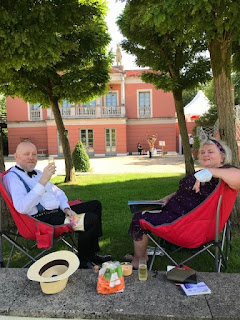We, who have spent two or three weekends a summer in Stow-on-the-Wold for the past decade, had been so comfortable in our usual flight path around the market square we hadn’t ever bothered to walk a few minutes further to find greater delights.

When we travel to any foreign destination, or even a domestic one for the first time, we research restaurants and cultural must-sees. But I have been going to this part of the Cotswolds regularly for almost 30 years. I got lazy.
My punishment: imagining the years we’ve wasted on average pub dinners when we could have been eating at The Old Butchers. Now that we know better, I predict every future trip will include a meal here.
In spirit, The Old Butchers is the lovechild of a French bistro and a cosy British country pub, taken under the wing of a godparent who owns a winery. It has all the attributes I look for in a perfect local restaurant. It’s family-owned and run, with the head chef in the kitchen and firmly in charge. The menu changes regularly based on seasonal availability. There’s a fabulous wine list, a comfortable, homey atmosphere and an informed, friendly staff that can give you insight into everything on the menu and match wines without fuss. Prices are excellent value for money. I wasn’t at all surprised to learn that head chef Pete Robinson is a veteran of foodie favourites Tresanton and Bibendum and that his wife Louise has been managing restaurants since she was 18. Including doing an exemplary job with this one. No surprise that the place has a “plate” listing in the coveted Michelin Guide. (One step below “star” level.)
Our introduction to this Cotswold wonder started with a tuna tartare for one and deep-fried courgette flowers on fresh seasonal pesto for the other. We couldn’t agree who had won that round of ordering. Both combined fresh, robust flavours with simple but elegant presentation. That courgette dish can be tough to find done well outside of Italy, especially when a whole, tiny courgette is included along with the bloom. It’s extremely easy to overcook the flower while leaving the veg far too al dente. This was spot on.
No contest who won the mains selection, since we shared a whole Cornish turbot. Often called the “king of fish”, beloved by epicureans since the time of the Ancient Romans, turbot is extremely expensive and very easy to overcook. Which may be why it appears so seldom on British menus; I last had it in the Basque Country. So what a delight to find it here, and done to classic perfection: grilled with orange slices slipped between slit in its skin, then served with a sauce of white wine, butter, herbs and just enough acidity to counter the rich fish. There was also a gravy boat full of addictive hollandaise sauce, a bit too much for the fish but perfect with the boiled potatoes. And to get your veg in, two kinds of cabbage: half a grilled sweetheart variety and a mound of finely-shredded Savoy cooked with hazelnuts and almonds. The unctuous ness of every bite made it clear they’d both been cooked with enough fats to counteract any health-giving properties of the simple vegetable.
The deserts on the menu looked fantastic, but we couldn’t finish the enormous feast for two, much less fit in sweets. That’s a treat to be left for next opera season, when booking The Old Butchers will be third on my list after obtaining performance tickets and accommodation.
And speaking of the opera, how was our second outing at Longborough this year?
The critics adored The Return of Ulysses. I was less convinced. This had nothing to do with Longborough’s interpretation, and everything to do with Monteverdi’s actual opera. To go with a crude description that will horrify the opera cognoscenti, there are baroque operas that have exquisite bits of music joined together by dirge-like harpsichord bits, and then there are Baroque operas that are pretty much ALL dirge like harpsichord bits. I have to put Ulysses… Which I had never seen before… Into this second category.There are no memorable bits here to request on classic FM, and nothing you will come out Tommy. Much of it is perfectly pleasant, but can also be monotonous. And a bit sleep inducing if it’s late afternoon in a very warm circus tent.
Yes, circus tent. Longborough’s plan to have an opera season whatever the changing COVID regulations meant erecting a circus tent in the grounds. An outdoor performance space provided some shelter, with highly flexible seats ready to adapt to changing regulations. Though things had started to ease, Longborough was enforcing stricter-than-necessary measures so each party sat two metres from the next and all were masked throughout.
The performers took to the challenge of working “in the round” seamlessly, with Longborough’s usual superlative levels of acting and singing. Setting the opera in an American context, with Ulysses a soldier returning from Afghanistan, the suitors as offensive rednecks and the gods as glittering rhinestone cowboys, added interest. Continuing social distancing, however, caused problems for Ulysses that we didn’t see in Die Walkure. In that earlier production of forbidden love, the inability of the actors to touch each other in life added to the tension of the drama. The climactic duet of Ulysses seemed false when a husband and wife reunited after a decade couldn’t embrace. I suspect I might have enjoyed the opera more with a more traditional staging and a more obvious happy ending with the lovers in each other’s arms.
The fact that I didn’t really warm to the opera wasn’t important. The experience of live music and performance, and returning to one of our beloved routines of the year, was a delight. By next year, let’s hope this all feels quite normal again.































